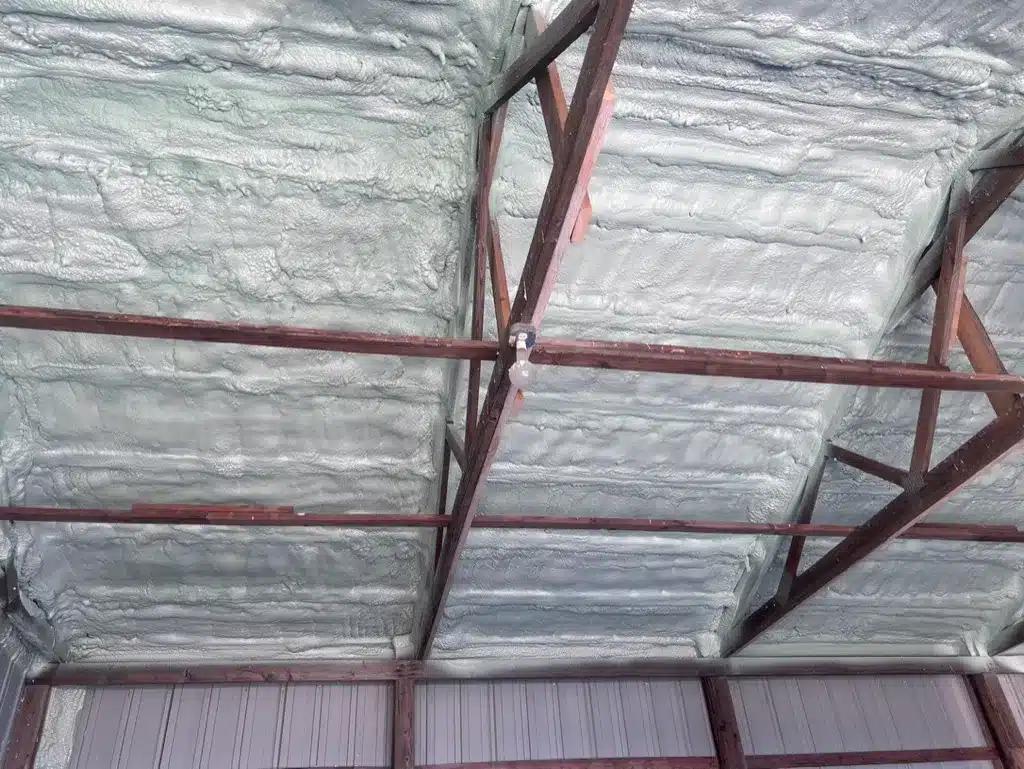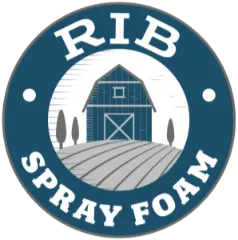Closed-cell spray foam is highly effective in high-moisture environments due to its low permeability, high structural rigidity, and ability to resist water absorption. It acts as both insulation and a moisture barrier, reducing the risk of mold growth, water intrusion, and condensation-related damage.
This article explains why closed-cell spray foam is suited for damp conditions, supported by technical comparisons, real-world data, and field-tested observations. All insights are based on Rib Spray Foam Company’s direct experience working in varied moisture zones across Colorado.
How Closed-Cell Spray Foam Performs in Wet Conditions
Closed-cell spray foam has a dense cellular structure that creates a rigid, waterproof barrier. Its permeability rating is significantly lower than other insulation types, making it effective at resisting moisture transfer in areas such as crawl spaces, pole barns, and basements.
Comparison Table: Closed-Cell Spray Foam vs. Other Insulation Options
| Insulation Type | Water Resistance | Air Sealing Ability | Permeability (Perms) | R-Value per Inch | Mold Resistance |
|---|---|---|---|---|---|
| Closed-Cell Spray Foam | High | High | <1.0 | 6.5 – 7.0 | Excellent |
| Open-Cell Spray Foam | Low | High | >10 | 3.5 – 3.8 | Moderate |
| Fiberglass Batts | Low | Low | >30 | 2.9 – 3.8 | Poor |
| Cellulose (Loose-Fill) | Low | Low | >25 | 3.2 – 3.8 | Low |
Technical Specifications
| Property | Closed-Cell Spray Foam Specification |
|---|---|
| Core Density | 2.0 lbs/ft³ |
| Permeance (1″ thickness) | 0.8 perms |
| Compressive Strength | 25 psi |
| R-Value (1 inch) | 6.5 – 7.0 |
| Dimensional Stability | <2% change (ASTM D2126) |
| Water Absorption | <0.5% by volume |

Regional Relevance: Performance in Colorado’s Moisture Zones
In Colorado, fluctuations in humidity and temperature often lead to vapor condensation, particularly in crawl spaces and unconditioned pole barns. Closed-cell spray foam is used frequently by Rib Spray Foam Company to mitigate these effects. The rigid barrier formed resists vapor diffusion and adheres directly to subflooring, rim joists, and wall sheathing without sagging or gaps.
Bonus Tip:
Apply foam directly onto clean, dry surfaces. In cold, high-altitude areas, pre-warming substrates can improve adhesion and reduce cure time.
Market Data and Third-Party Validation
- According to the U.S. Department of Energy, buildings account for 40% of total energy consumption. Closed-cell spray foam reduces air leakage, leading to energy savings of up to 20% (DOE Source).
- A study from the Building Science Corporation confirmed that closed-cell foam can provide over 90% reduction in moisture transfer compared to open-cell options (Building Science Corporation).
- ICC-ES reports list closed-cell SPF as compliant with Class II vapor retarder classifications, validating its use in moisture-critical assemblies.
Things to Consider Before Making a Decision
- Moisture Level of the Space: Closed-cell is suited for areas with ground moisture, humidity swings, or potential water exposure.
- Building Material Compatibility: Confirm adhesion on substrates like metal, OSB, and concrete.
- Code Compliance: Check local building codes for required vapor retarders.
- Budget: Higher upfront cost, but long-term value from energy savings and moisture protection.
Bonus Tip:
In enclosed areas like crawl spaces, ensure there is adequate mechanical ventilation post-installation to manage trapped humidity.
Relevant Services from Rib Spray Foam Company
- Closed Cell Spray Foam: Creates a rigid thermal and moisture barrier ideal for high-humidity environments.
- Crawl Space Spray Foam: Applied to joists and walls to prevent condensation and improve indoor air quality.
- Pole Barn Spray Foam: Protects agricultural or storage structures from moisture ingress.
- New Construction Spray Foam: Integrated early to provide long-term resistance against air and moisture leaks.
Common Questions Before Choosing Closed-Cell Spray Foam
Does it work in unvented spaces?
Yes. Its low permeability allows it to function as a vapor retarder, making it effective in sealed environments.
Can it replace traditional vapor barriers?
In many cases, yes. A 2-inch application often meets the Class II vapor retarder classification.
What thickness is required for moisture protection?
A minimum of 1.5 to 2 inches is typically sufficient for most high-moisture zones.
Does it support mold growth?
No. The material itself is inert and moisture-resistant, which inhibits mold development.
Get Expert Insulation Guidance
To assess whether closed-cell spray foam fits your high-moisture environment, contact:
Rib Spray Foam Company
Email: [email protected]
Phone: (970) 518-2883
Expect practical insight based on regional conditions and hands-on installation experience.
FAQ
How long does closed-cell spray foam last?
It typically lasts over 30 years with no significant degradation when properly installed.
Can closed-cell foam be applied to damp surfaces?
No. Surfaces must be dry and free of condensation. Moisture impairs adhesion and curing.
Is closed-cell insulation safe in flood-prone areas?
Yes. Its low absorption rate prevents water retention, reducing cleanup needs after flooding.
What maintenance does it require?
None under normal conditions. Monitor sealed areas for structural movement or penetrations.
Can it be used with other insulation types?
Yes. Often paired with fiberglass or mineral wool for hybrid assemblies where moisture risk is localized.



